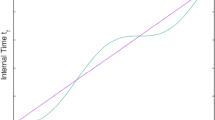Abstract
THE usual exterior Schwarzschild line element shows an obvious singularity for a certain value of r, say r = a. Since a is in every known case much smaller than the radius of the spherical body producing the field, the existence of the singularity appears to be of little interest to astronomers. At the other end of the scale, a discussion of the gravitational field of an ultimate particle, without reference to electromagnetism or quantum theory, might appear equally devoid of physical meaning.
This is a preview of subscription content, access via your institution
Access options
Subscribe to this journal
Receive 51 print issues and online access
$199.00 per year
only $3.90 per issue
Buy this article
- Purchase on SpringerLink
- Instant access to full article PDF
Prices may be subject to local taxes which are calculated during checkout
Similar content being viewed by others
References
Ann. Soc. Sci. Brux., A, 53, 51 (1933), in particular p. 82; I am indebted to Prof. G. C. McVittie for this reference.
Author information
Authors and Affiliations
Rights and permissions
About this article
Cite this article
SYNGE, J. Gravitational Field of a Particle. Nature 164, 148–149 (1949). https://doi.org/10.1038/164148b0
Issue date:
DOI: https://doi.org/10.1038/164148b0
This article is cited by
-
New problems in general relativity
Russian Physics Journal (1998)
-
Strong gravitational fields and geometry in the large
Soviet Physics Journal (1984)
-
Requirements imposed on solutions of general relativity by geometry in the large
Soviet Physics Journal (1977)



